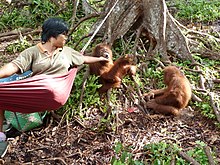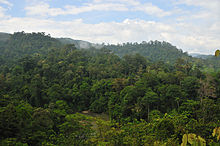Borneo Orangutan Survival Foundation
| The Borneo Orangutan Survival (BOS) Foundation / Yayasan BOS | |
|---|---|
| legal form | Nonprofit organization |
| founding | 1991 |
| founder | Willy Smits, Peter Karsono and others |
| Seat | Bogor |
| motto | The protection of the orangutans and their habitat with the participation of the population |
| purpose | Species and nature protection |
| Action space | Kalimantan / Indonesia |
| Employees | about 400 |
| Website | orangutan.or.id |
The Borneo Orangutan Survival Foundation (BOS Foundation) is a foundation under Indonesian law and an Indonesian non-governmental organization . Its purpose is to preserve the orangutans on Borneo and their rainforest habitats in cooperation with government agencies (especially the Indonesian Ministry of Forestry), the local population and other stakeholders. The foundation's administrative headquarters are in Bogor , West Java .
Foundation and history
In 1991 the "Orangutan Conservation Project" was founded by the Dutch forest scientist Willie Smits and others. After two further name changes, the organization was finally given its current name in 2003.
Smits took care of an orphaned orangutan baby in 1989 and nursed it back to health. A short time later, he was entrusted with further orangutan young animals for rearing, so that the original initiative had to be put on a broader basis. With the help of colleagues from the rainforest organization Tropenbos, the teacher Peter Karsono, students from the international school in Balikpapan and other people, the first forerunner organization of today's BOS Foundation was founded.
With the expansion of its activities, the awareness of the BOS Foundation also grew internationally. Over the years, independent organizations have been founded in Australia, Denmark, Germany , Great Britain, Japan, the Netherlands, Sweden and Switzerland, which support the Indonesian BOS Foundation financially and ideally.
Working method
The way of working is essentially based on three pillars: Rescue, rehabilitation and (re) release of orangutans. In order to guarantee the latter, the BOS Foundation must also secure suitable forest areas for the animals; the organization thus also contributes to the protection of the rainforest. The foundation conducts reforestation and cultivation activities, carries out educational work in water management and fire protection and monitors rain forest areas to protect against poaching and illegal logging. Cooperation with the local population is also essential because the animals released into the wild would not survive without their consent. The BOS Foundation therefore carries out various educational projects and provides alternative sources of income.
rescue
The foundation operates two rescue and rehabilitation centers for orangutans for a total of approx. 800 animals in Samboja Lestari (province of East Kalimantan ) and Nyaru Menteng (province of Central Kalimantan near Palangka Raya ) on Borneo .
The ways the orangutans get to BOS are different and mostly painful for the animals. Many of them are confiscated from private captivity by the police and the nature conservation authority BKSDA (Balai Konservasi Sumber Daya Alam) and placed in the care of the foundation. Others come to BOS after being apprehended on oil palm plantations or near settlements. These often include orphaned young animals whose mothers have been killed or otherwise perished.
Rehabilitation of orangutans
Rehabilitation is to be understood here as all measures that enable orphaned, sick or injured orangutans to survive independently in the jungle again and to reproduce there. The specific measures depend on the age and state of health of the individual animal.
Only those animals that are too old or too sick to live in the wild are kept in the stations permanently. With all the rest, the goal is to release them back into the wild.
Orangutans that come to BOS as adult or almost adult animals from the wild are immediately relocated to other forest areas after a health check (translocation). They already have the skills necessary for a life in the wilderness.
Orangutans between the ages of three and five who have at least basic skills for survival in the forest receive medical care in the stations and support in their natural behavior. These animals can get used to their natural environment again relatively quickly.
Orphaned young animals of infancy, on the other hand, who would still be completely dependent on their mother, are prepared for a life in their natural habitat in a usually six to seven-year training (corresponding to the care period of six to eight years by the mother under natural conditions) . Necessary skills of the orangutans are, for example, recognizing and locating edible plants and fruits, recognizing poisonous animals and plants, building sleeping nests, efficient and safe climbing and locomotion techniques in the treetops, orientation in the forest, social interactions with conspecifics and other. Likewise, these very young orangutans in particular need intense emotional attention from the human care staff (so-called baby sisters), especially since they are usually traumatized by the often violent death of their mother.
During the rehabilitation process, the young animals go through different learning levels and live in groups, separated by age and stage of development. At the stations, BOS uses small patches of forest as "forest schools", in which the young monkeys are "trained" for a life in the wilderness during the day. Your last stop before they are released for reintroduction are river islands, in which the animals then live almost under natural conditions. Around 150 orangutans are now temporarily living on the river islands and are learning the skills they need to soon return to the rainforest.
Forest security and management
The basic requirement for the release of orangutans is the existence of forest areas that meet certain minimum criteria:
- sufficient food crops, e.g. B. wing fruit plants
- sufficiently large territory
- Protection against deforestation or slash and burn, generally long-term protection status
- no competition with any orangutan populations already living in the protected areas.
Forest areas that meet all of these requirements are difficult to find in today's Borneo, so for a long time it was hardly possible for the BOS Foundation to release orangutans into the wild. In addition, land on a large scale cannot be acquired as private property under Indonesian law, but remains in principle with the state. However, the state grants differently defined usage concessions, i.e. leases the land for a fee, usually for commercial purposes such as logging or the creation of plantations. However, since 2008 it has been possible to acquire a concession specifically for nature conservation purposes (Eco System Restoration Concession). This is legally equivalent to a commercial license and can only be acquired by companies. For this reason, the BOS Foundation founded the company PT Restorasi Habitat Orangutan Indonesia (PT RHOI), which is technically responsible for the release and release areas.
The acquisition of the aforementioned nature conservation concession is planned for 60 to 90 years; further reintroduction areas of this type are to follow. In addition, the BOS Foundation also concludes agreements with private concessionaires and uses reintroduction opportunities in existing state protected areas.
Release
An important aspect of all reintroduction and protection projects is the acceptance of the local population. In addition to information events, training courses are held for B. initiated for income-generating measures and hired local people as rangers . The actual release of the orangutans in the protective forest is also associated with considerable logistical and financial expenditure. For example, stations for rangers, veterinarians and scientists, including the necessary supply infrastructure, must be provided in the remote release areas. Airplanes or helicopters are organized to transport the animals, and temporary helipads have to be set up.
The animals to be released into the wild are vaccinated in the stations and subjected to extensive health checks. After being released into the wild, each individual is observed for at least one year, through visual contact and via mini-transmitters implanted in the skin. In the more recent reintroductions (February 2012 to April 2014) 162 animals were released into the wild. Two births and eleven deaths were recorded during this period. Further releases are being planned. In total, over 500 orangutans have been released into protected rainforest areas since the foundation was established.
Afforestation
From 2001 to 2011, the foundation also undertook extensive reforestation in the Samboja Lestari area near the port city of Balikpapan . The afforestation has been largely completed since 2011 and the work of the BOS Foundation in Samboja Lestari focuses on conservation measures and the care of the animals housed there (orangutans and sun bears ). However, the area of approx. 1,800 ha is too small for orangutans to be released into the wild.
Sun bears
The 50 or so sun bears from Samboja Lestari all come from unsuitable private keeping and can usually no longer be released into the wild. The bears are too used to humans and would seek proximity to human settlements, which would lead to serious conflicts.
Mawas area
The Mawas area comprises an approx. 377,000 hectare lowland rainforest area in central Kalimantan. "Mawas" means orangutan in the language of the local inhabitants, the Dayak. The region is home to one of the last major orangutan populations of around 3,000 animals as well as many other threatened animal and plant species.
Together with Australian and other international actors, the foundation was involved in the Kalimantan Forest Carbon Partnership (KFCP) project to develop and implement the REDD program to reduce global deforestation trends . Among other things, conflicts of use with the local population resulted in the KFCP project being discontinued. The BOS Foundation continues to operate the Camp Tuanan research center. There, Indonesian and international scientists conduct behavioral observations on wild orangutans and other research projects.
Web links
- BOS Australia
- BOS Denmark
- BOS Germany
- BOS Japan
- BOS Sweden
- BOS Switzerland
- Orangutan Land Trust
- Orangutan Protection Foundation
Individual evidence
- ^ BOS Switzerland: About BOS. Retrieved June 2, 2019 .
- ^ BOS Switzerland: Sustainable Development. Retrieved June 2, 2019 .
- ↑ Station Samboja Lestari: Rehabilitation and release into the wild in Ostkalimantan (English) ( Memento of the original from November 12, 2014 in the Internet Archive ) Info: The archive link was inserted automatically and has not yet been checked. Please check the original and archive link according to the instructions and then remove this notice.
- ^ Station Nyaru Menteng: Rehabilitation and release into the wild in Central Kalimantan (English) ( Memento of the original from November 12, 2014 in the Internet Archive ) Info: The archive link was automatically inserted and not yet checked. Please check the original and archive link according to the instructions and then remove this notice.
- ^ BOS Switzerland: reintroduction. Retrieved July 2, 2019 .
- ^ Rehabilitation: From orangutan orphan to forest man
- ^ BOS Switzerland: The story of BOS. Retrieved June 2, 2019 .
- ↑ Restorasi Habitat Orangutan Indonesia (RHOI): Forest Forever for Orangutans
- ^ BOS Switzerland: History of BOS. Retrieved June 2, 2019 .
- ↑ Sun bears: Sun bears at BOS
- ^ REDD Monitor: Australia shuts down the Kalimantan Forest Carbon Partnership
- ↑ Mawas area: Mawas Peatlands Conservation Area Project



